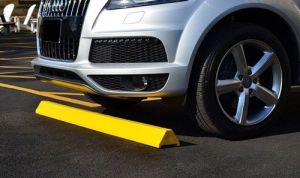Wheel stops (also called parking blocks, parking stops, or tire stops) are an important element to any parking lot. They are designed to contact a vehicle’s tires to keep it from pulling too far forward in a parking lot. Wheel stops are often used to protect signs, walls, curbs or even other cars. They are also used to keep the front end of a vehicle from blocking a sidewalk so there is plenty of room for foot traffic and wheelchairs.
There are generally two types of wheel stops that we install–concrete and plastic. Here in the Dallas, TX area, wheel stops are typically 72” long–long enough for both front or rear wheels of a vehicle to touch the wheel stop. C & D offers wheel stop installation services all over the DFW area and beyond. We have been installing wheel stops since 1981.
The benefits of concrete wheel stops/parking blocks are the most economical and the most common. They are attached to the parking lot either by rebar or epoxy. They can also be painted for aesthetics or functional purposes if desired. We can install these wheel stops on both concrete or asphalt and in parking lots or parking garages. The main disadvantages to concrete wheel stops is their durability. Over time, they can crack down the middle from cars tires constantly bumping them. Concrete wheel stops are sometimes painted as part of a parking lot striping project. If concrete wheel stops are painted, they will need to be re-painted frequently in order to look good. If you are looking to only buy wheel stops, you can do so through our sister company Southwest Scaffolding. The wheel stops we sell are hexagonal concrete. They are 72 inches long, contains two sticks or rebar and weigh 200 lbs each.
Plastic wheel stops are more expensive than concrete wheel stops, however, their advantage is they look better and are more durable. plastic wheel stops and parking blocks come pre-colored from the manufacturer. They are manufactured with a dye that colors the plastic all the way through so the color will not wear off over time and they don’t scuff as much as their concrete counterparts. We usually install these wheel stops with concrete anchors, rebar, or epoxy. You can also buy wheel stops made from recycled plastic, these are useful if you are managing a building with a LEED certification. Right: plastic wheel stop from Barco Products.
Parking Garage Wheel Stop Installation
When installing wheel stops in parking garages, you will need to consider how you want them attached to the concrete. They can be attached either by anchor, rebar, or epoxy. Anchoring them will insure that they will not move over time. Once installed, they are effectively permanent. Installing wheel stops with epoxy is effective but over time, they will come loose and must be reattached.
Rebar is used to install wheel stops into an asphalt parking lot. Since asphalt is actually an extremely viscous liquid, we can secure wheel stops on an asphalt parking lot by hammering rebar through the wheel stop and into the asphalt.
Epoxy is the most cost-effective way to install wheel stops in a parking garage because of post-tension cables. These cables give the suspended concrete its strength and must be located with specialized equipment and marked prior to making any holes in the concrete. The cost of locating the cables makes it much more expensive to anchor wheel stops into a parking garage.
If you just want to buy wheel stops, you are are the right place. We sell wheel stops through our sister company Southwest Scaffolding, which supplies construction materials and scaffolding in the DFW area and all over the US.
Every parking lot needs a way to keep vehicles properly positioned. Wheel stops serve this role by creating a physical barrier that contacts a vehicle’s tires before it moves too far forward. This helps:
- Protect other parked vehicles and surrounding structures
- Keep fire lanes, crosswalks, and sidewalks accessible
- Improve pedestrian safety in busy parking areas
- Maintain compliance with ADA standards
Whether you call them wheel stops, parking blocks, or tire stops, they all serve the same purpose: keeping your parking lot safe and organized.
In addition to parking blocks, we also install speed bumps and bollards. Speed bumps can make a parking lot much safer for pedestrians and motorist by forcing vehicles to slow down in high traffic and tight areas. Bollards are used to keep vehicles from hitting parts a building or structure or used to protect pedestrians in high traffic areas of your property.
C & D Commercial Services provides professional wheel stop installation services throughout the Dallas–Fort Worth area. Whether you’re searching for wheel stops in Dallas TX, tire stops near Fort Worth TX, or a parking block installation contractors, our team is ready to help!
We proudly serve:
- Dallas
- Fort Worth
- Plano
- Frisco
- Arlington
- Irving
- Richardson
- Carrollton
- Denton
- Allen
- Surrounding Areas
Since 1981, C & D Commercial Services has been the trusted contractor for wheel stop installation services across Dallas–Fort Worth. Whether you need concrete parking blocks, plastic wheel stops, or a reliable parking block installation contractors near you, we can handle commercial projects of any size.
Contact us today to schedule your wheel stop installation quote and keep your parking lot safe, compliant, and looking its best.






